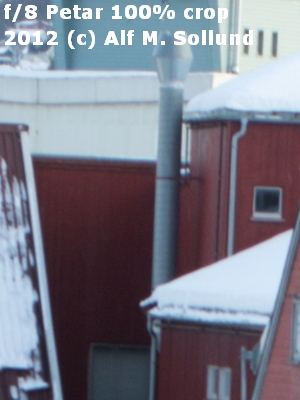This is what I call a pancake lens – Perar 4/28 MC Super-Tpiplet
Please feel free to drop me a comment!
The purpose of this text is to summarise first impressions from a Perar 4/28 MC Super-Tpiplet on a NEX-5N, and to make a first comparison on IQ versus a Leica ASPH 28/2,8. Please note that this is NOT a proper test.
Summary and conclusions
My first impressions of thee Perar 4/28 MC Super-Tpiplet with a Leica M-mount is an incredibly small and compact lens with great performance on a NEX-5N. For all practical purposes the sharpness is excellent and consistent through apertures with good corner sharpness as well. The handling of lens with manual focus is fairly good in particular given the small size. I miss a functional lens cap.
Please remember that this comparison is first impressions and look on resolution, and that bokeh, distortion, flare and ghost have not been tested. Yet.
Please see a photo of the Petar on a NEX-5N (with a JTEC L-bracket).
The lens comes without proper caps, but with a tiny hood
This is a first tryout of a Perar 4/28 MC Super-Tpiplet with a Leica M-mount. And no, the “Tpiplet” is not a typo by me. This is probably the smallest 28mm for full frame available as can be seen from photos. The lens came in a cardboard box including papers, a tiny lens hood and threaded back/front caps. I consider the caps more for transport than everyday use since they are too small and cumbersome to handle, and can be mounted on the small hood. To protect the front of lens I immediately made my own front lens cap from a soda cap, and uses a spare back lens cap from a Leica lens to protect mount. It would have been better if the vendor could include cap to protect the lens mount as well as a front lens cap covering hood.
Here is a couple of photos comparing size with the compact Leica 28/2,8.
Impressive build quality and craftsmanship
I couldn’t help but being impressed by the mechanical engineering and apparent build quality. All moving parts such as the manual focus are very smooth. The manual focus is done with a quarter of a turn from infinity to 0,8m through a small handle at bottom and works well.
The 10 bladed aperture is without click stops with markings of f/4 to /16 and is done by rotating front. This best done with hood mounted since the front is very tiny. Although marking stops at f/16 it’s possible to reduce further. There are markings showing DoF for apertures. Comparing with other lenses I would guess that these are derived by CoC of 0.03mm, so I prefer to use more modern estimates and treat the DoF scale as if the f/8 marking was actually labelled f/4, the f/16 marking f/8 and so on, i.e. a two-stop adjustment. This corresponds to a CoC of 0.015 mm, half the traditional size.
Comparing Perar with Leica lens – not bad at all
At the 3rd of March 2012 I did not have my M9 at hand, so I did some shootouts with a Sony NEX-5N through a Voigtlander adapter. To compare I used one of the best 28mm around, the LEICA ELMARIT-M 28mm f/2.8 ASPH. All these “tests” were done mounting NEX-5N on solid tripod. During photo shootout it was sunny with rather hard low light and a cityscape high on contrast with snow and shadows. All settings were done manually. All photos were shoot in RAW and imported in LR 3.4. Processing was limited as much as possible, and no sharpening was done in processing nor in export.
Please see 100% crops below for comparison. I would assume that on a 1,5x crop sensor such as the NEX-5N some corner weaknesses are “hidden”. You should notice that this is only sharpness at one given condition,and that bokeh, distortion, flare and ghost have not been compared. Yet.
As far as I can see from these photos the Perar is very consistent on sharpness through apertures, its quite sharp at largest aperture f/4, actually on pair with the Leica. At f/8 the sharpness of the Perar has not improved from f/4 on corner, but the Leica is much sharper. The sharpness in centre of the Perar is very good, and does not vary much from largest to smallest aperture.












03/09/2012 at 20:46
[…] This is what I call a pancake lens – Perar 4/28 MC Super-Tpiplet … I consider the caps more for transport than everyday use since they are too small and cumbersome to handle, and can be mounted on the small hood. To protect the front of lens I immediately made my own front lens cap from . […]
04/04/2012 at 02:36
Can’t wait for further test with a M9. could you also upload some other pictures, more contrasted, more difficult to manage for such a small lens? Or some portrait examples to see how skin is treated?
Thanks,
thaisrox
04/10/2012 at 09:31
Thanks Eric,
Good ideas. The problem is as always time 🙂